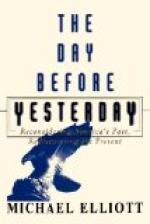Of a very different type was another constant and always welcome visitor to our house, Sir Edwin Landseer, the painter. He was one of my father and mother’s oldest friends, and had been an equally close friend of my grandparents, the Duke and Duchess of Bedford. He had painted three portraits of my father, and five of my mother. Two of the latter had been engraved, and, under the titles of “Cottage Industry” and “The Mask,” had a very large sale in mid-Victorian days. His large picture of my two eldest sisters, which hung over our dining-room chimney-piece, had also been engraved, and was a great favourite, under the title of “The Abercorn Children.” Landseer was a most delightful person, and the best company that can be imagined. My father and mother were quite devoted to him, and both of them always addressed him as “Lanny.” My mother going to call on him at his St. John’s Wood house, found “Lanny” in the garden, working from a ladder on a gigantic mass of clay. Turning the corner, she was somewhat alarmed at finding a full-grown lion stretched out on the lawn. Landseer had been commissioned by the Government to model the four lions for the base of Nelson’s pillar in Trafalgar Square. He had made some studies in the Zoological Gardens, but as he always preferred working from the live model, he arranged that an elderly and peculiarly docile lion should be brought to his house from the Zoo in a furniture van attended by two keepers. Should any one wish to know what that particular lion looked like, they have only to glance at the base of the Nelson pillar. On paying an afternoon call, it is so unusual to find a live lion included amongst the guests, that my mother’s perturbation at finding herself in such close proximity to a huge loose carnivore is, perhaps, pardonable. Landseer is, of course, no longer in fashion as a painter. I quite own that at times his colour is unpleasing, owing to the bluish tint overlaying it; but surely no one will question his draughtsmanship? And has there ever been a finer animal-painter? Perhaps he was really a black-and-white man. My family possess some three hundred drawings of his: some in pen and ink, some in wash, some in pencil. I personally prefer his very delicate pencil work, over which he sometimes threw a light wash of colour. No one, seeing some of his pen and ink work, can deny that he was a master of line. A dozen scratches, and the whole picture is there! There is a charming little Landseer portrait of my mother with my eldest sister, in Room III of the Tate Gallery. Landseer preferred painting on panel, and he never would allow his pictures to be varnished. His wishes have been obeyed in that respect; none of the Landseers my family possess have ever been varnished.




